#Erika armpit is good too
Explore tagged Tumblr posts
Text
Barbies Ranked
Wherein I rank the main characters and plots of every movie I've seen in the BCU (Barbie Cinematic Universe)
Clara-Barbie in The Nutcracker (2001)

The OG. First barbie movie I ever saw. Yes there were barbie movies that came out before this, but this is the only one I care about. The movie that kicked off the ballet phase, so automatic points there. Wierd animation looking back, but really cool when I was a kid. I had a crush on the nutcracker and I thought it was cool that Clara could be kickass and kind and girly all at the same time. Kind of trippy to watch now because it could be a little disjointed but honestly? It still holds up.
Barbie:
10/10 that's a fuckin barbie right there
Plot:
100/10 cant beat the classics.
Rapunzel- Barbie as Rapunzel (2002)

Okay I'm not gonna lie, it's been forever since I watched this. But I remember I liked the magic paintbrush and hated the prince. Cool sassy dragon sidekick. Boring otherwise. Not because of barbie, she did what she always does, not her fault she got a bad script.
Plot:
3/10 for walking so Tangled could run.
Barbie:
7/10 kind of a flat character
Odette- Barbie of Swan Lake (2003)
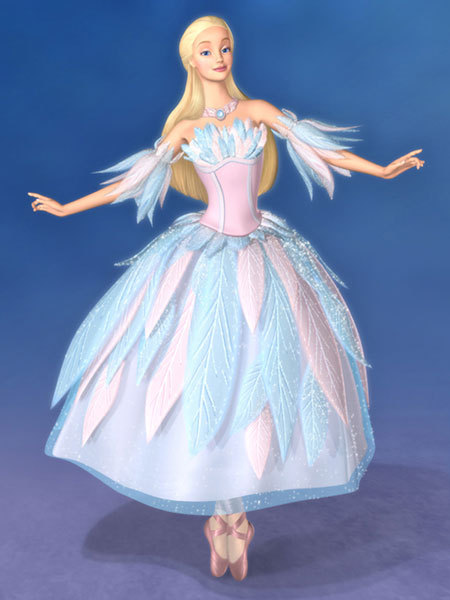
THIS SHIT RIGHT HERE. When I say I cried yall dont understand i fucking CRIED bitch the performance was breathtaking i felt like i was LIVING in the story. This movie made me beg my mom to let me take ballet classes, which sucked, but not this movies fault. It inspired me, a shithead six year old delinquent in training, to want to be beautiful and elegant and utterly tragic. Odette has never been played by a finer actress, Barbie just gets the nuance of this character and by god does she perform. My only complaints are odiles voice is fucking annoying and rothbart seemed to be heavily based on Jewish stereotypes which is obviously pretty bad.
Plot:
9999999/10 I mean even the barbie flourishes were good
Barbie:
1000/10 she snapped
Anneliese and Erika- Barbie as the Princess and the Pauper (2004)

Wooooo boy was this a dick punch of a movie. First of all, the plot? You need to suspend a hell of a lot of disbelief to watch this without treating it like a comedy. To be fair, it's a really good comedy. I will get it out that I think barbie did great playing two roles at once. Hard to believe that's just her, but recall this is before barbie got her friends in on the acting scene. For what she had, she did great. That said, she isnt the reason I remember this movie. Preminger stole the fucking show. Although upon rewatch , I realized a similar issue with the swan lake thing above so I'm a little worried about the villain pattern here. Will keep looking.
Plot:
8/10 I liked the songs
Preminger:
100/10 she HAS the range
Annika- Barbie and the Magic of the Pegasus (2005)

Again, not a lot of memory here. There was a pegasus, like a kingdom of them I think? I'm pretty sure this one had more ballet and ice skating so that's cool. I think I remember Annika being like, kickass for a princess movie. I cant even remember the bad guy so that's all to say there.
Plot:
4/10 ice skating cool
Barbie:
7/10 everyone has a wierd period.
Genevieve- Barbie in the 12 Dancing Princesses (2006)
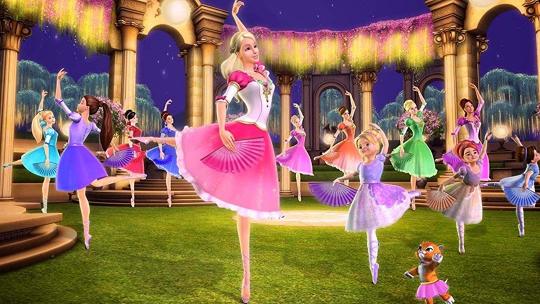
This is hands down my favorite movie. Why? Lots of dancing. Lots of characters. The sisters all have distinct personalities. The villain is super fucking sinister as she attempts to murder their father. The music is so sweet. Theres the usual romance, but it's not the main focus of Genevieve to catch a man. She loves her sisters and her father and just wants to dance to remember her mother. Shes brave and clever and I used to dream of having a magic room of my own where I could run away to dance. Basically? This movie slaps. You should check it out, if you haven't seen.
Plot:
😭/10 full bias I root for them the entire time
Barbie:
10000/10 honorable mention to actresses for sisters, very decent work all around.
Rosella- Barbie as the Island Princess (2007)

dude this movie is incredible. The inherent drama of being barbie Tarzan. And the music? Start humming "I want to know" within range of anyone who's seen this movie even ONCE and its like unlocking a deep cover memory. Her dress was great, the animals were fantastic support, the prince was a legitimate himbo. Villain was great too, huge bitch, huge hair, almost won.
Plot:
67882/10 everyone carried their weight here
Barbie:
9/10 one point taken off because feral island girl had no armpit hair and that always bothered me
Anyway its 8 am now and I did this instead of sleeping so I'm gonna just call it here. I have seen more barbie movies, these are just the ones up to 2008 that I care about. If you guys wanna see more lmk and I'll make this part one.
#barbie#barbie movies#barbie in swan lake#barbie in the nutcracker#barbie the island princess#rapunzel#pegasus
411 notes
·
View notes
Text
Moving to the Rhythm for a Sweet Victory (Pt. I)
When people come across the sport of gymnastics, the thing that would almost immediately enter their minds are the flips, cartwheels, twists, and turns. Granted that it is correct to some extent, avid gymnastics fans would tell you about the two subtypes of the sport: artistic gymnastics and rhythmic gymnastics. Where artistic gymnastics pertains to a number of events in a single competition that focus on technicalities – pommel horse, still rings, vault, parallel bars, high bar, and floor for the men’s division; and floor exercise, uneven bars, balance beam, and vault for the women’s division – rhythmic gymnastics is only comprised of music-accompanied floor routines that focus mostly on presentation and style, and largely incorporate a variety of apparatuses like hula hoops or ribbons.
And for the last and final blog post of this sport review series, we will be reviewing the Individual Women’s Rhythmic Gymnastics Match at the 2016 Summer Olympics in Rio, Brazil. But before we get right into the juicy portion of this review, i.e., the analysis of the game itself, we will first be flipping into the basic need-to-knows of the sport.
Court Dimensions
According to the MasterClass website (A Guide to Competitive Rhythmic Gymnastics, 2020), the floor area to be used in rhythmic gymnastics has to measure 13 meters by 13 meters in width and length. Moreover, as said by the Department of Local Government, Sport and Cultural Industries of Australia (2019), the height of the hall has to at least be 8 meters, although international halls would have to have a measurement between 10-12 meters.
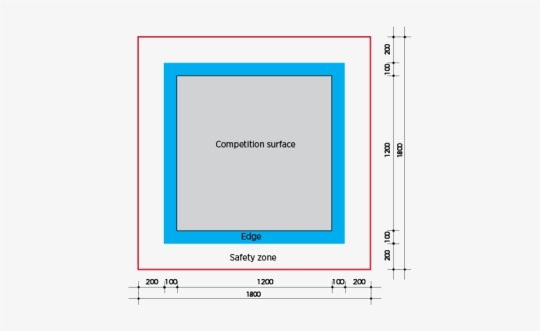

[all rights reserved to the original owner of the graphic: Aphrodite Cup and Olympics]
Equipment
Like any other sport, rhythmic gymnastics also has a set of materials that are essential equipment in carrying out the beauty of the sport. This sport especially has 5 pieces of apparatus that are not only very important but are also basically the main pillar of the game: the rope, hoop, ball, ribbon and club (Gymnastics in Vernon). Starting with the rope, it is a string of the right length and width that is cut fit to the athlete using it; It may be made of hemp or a synthetic material that retains the qualities of lightness and suppleness. Its length, as previously stated, is in proportion to the size of the gymnast. When the middle of the rope is held down by the feet, both ends should reach the gymnasts' armpits. More often than not, electrical tape is placed either at the ends of the rope or in the middle in order to increase its visibility. The ends would also have to be well-taken care of because it may come undone or become frayed, even in the middle of a routine. Next, the hoop is a circular piece of apparatus, similar to a toy hula hoop, that is determined by level and by height. The interior diameter is from 51 to 90 cm and the hoop must weigh a minimum of 300g; it can also be made of plastic or wood, depending on the gymnast’s preference and its ability to retain its shape. When choosing out a hoop, it has to be made sure that the weight is just enough for the athlete to be utilizing it. Moreover, when it is being transported, the hoop should not in any way be bent nor melted (heat, metal and lights may melt it) or else it, obviously, cannot be used anymore.
After the hoop is the ball, and like the hoop, it is also a circular piece of apparatus. Senior and junior gymnasts use a ball that is 18 to 20 cm in diameter and must have a minimum weight of 400g. Starting out with it, the ball would have to be inflated properly before it reaches the hands of the gymnast, and from time to time, it would also have to be reinflated. One way to determine if the air inside is just enough, is to dig in one’s fingers into it and if the ball cannot be squished, then it is too inflated. That, or the gymnast can also bounce the ball and see if it does not bounce to know if it is too deflated. A common rule for the maintenance of the ball is: “not to use anything on your ball that you would not use on your face.”
The fourth apparatus is the clubs, and these are basically a pair of short bat-like equipment that must weigh a minimum of 150 grams per club. Though they are not as high maintenance as the other apparatuses, it should be still be well-taken care of because they can still break. Furthermore, the clubs can also be taped or not taped, depending on whether or not the gymnast needs the balance and grip more user friendly. The ribbon/sis the fifth apparatus of rhythmic gymnastics, and it comes in different lengths according to the different age levels. The ribbon itself must be at least 35 g (1.2 oz), 4–6 cm (1.6–2.4") in width and have a minimum length of 6m (20') for seniors and 5m (16.25') for juniors. The ribbon must be in one piece. The end that is attached to the stick is doubled for a maximum length of 1m (3'). They are basically thin strips of fabric that have to receive extra care because of its fragility – it frays, tears and catches on things easily, so the gymnast has to be extra careful in handling it before an important competition because once it tears, it can no longer be reused. Ribbons should also be ironed every 10-14 days and always before a competition. Accompanying the ribbons are the ribbon sticks, and these are the parts that gymnasts hold in order to twirl the ribbon around.
Aside from the 5 apparatus are minor, yet still important, equipment, that which are: toe socks/toe shoes (needed as appropriate competition footwear), thera bands (supports muscles and joints as rehabilitation), and a gym bad (used to store in the apparatuses safely.) The costume/outfit is also important in rhythmic gymnastics not only because they add to the artistry of the performance but also has to be freeing enough that it does not become a hindrance to movement.
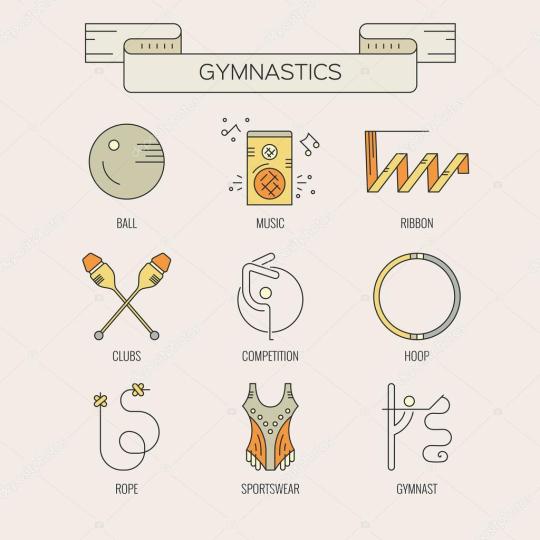
[all rights reserved to the original owner of the graphic: Deposit Photos]
Basic Skills
Stated in a document entitled the Special Olympics Rhythmic Gymnastics Coaching Guide (2008), there are about 4 categories of basic skills that a rhythmic gymnast needs to know in order to fully adopt the sport. Of those 4 categories are: jumps/leaps, pivots/turns, balances, and flexibilities.
JUMPS/LEAPS
This category requires good ankle strength as well as flexibility. Core strength is also necessary when executing one of the skills under this category in order to maintain a stable upper body position during jumps and leap, and have control of the arm position.
Cat leap
Chassé
Hitch kick
Leap
Step hop
Straight jump
PIVOTS/TURNS
Executing one of the skills under this category greatly necessitates good posture and body alignment, as well as core strength and balance.
Chainé turn
Passé pivot
Tiptoe turn
BALANCES
Arabesque (front and back)
Passé
Relevé
FLEXIBILITIES
Back arch on knees
Body waves (front, back and side)
Grand battement
Not only these, but as a fundamental, an upcoming rhythmic gymnast would also have to become familiar with the utilization of a rope (though, this one isn’t as commonly used as the other apparatuses,) a hula hoop, a club, ribbon/s, and/or a ball in their set routine for the floor.
Technical Skills
Because there are about five disciplines under rhythmic gymnastics itself, each discipline has its own set of technical skills. Attached to this post is a table of said skills, as per the international code of points, uploaded by Niki Tasika (2012) on ResearchGate as part of the research conducted by George Dallas et al. (2012):
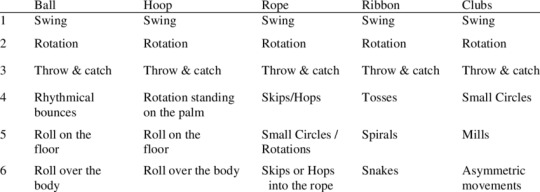
For a more specific table of skills for each discipline, attached here is the figures presented in the document published by USA Gymnastics (Beginning Rhythmic Skill Lists and Instructor Tips):

Tactical Skills
A competing rhythmic gymnast’s opponents on the floor is only their own self and the judges scoring the routine. So, it is important that, in order to be awarded honors and win competitions, the gymnast must start with their own person in training, improving, and applying tactics on (GKD Gymnastics, 2019).
First, the gymnast has to be committed; they have to really exert their all in attaining a mastery of the sport, to make time for training and for the competitions, and to work hard and not give up when met with obstacles. Next, they have to take care of themselves, and this includes properly stretching the body before training/executing a routine, eating healthily, and also asking for help in some movements if they feel that they can’t do it on their own, lest they’ll injure themselves. And speaking of stretching, it is also recommended for gymnasts to stretch everyday in order to improve their body’s flexibility (Erika, 2020). Not only that but they also have to be positive and supportive to their own self because one of life’s greatest motivators is the self. If the gymnast would be crowded with negativity and refuses to be proud of how much they’ve progressed, then being able to use the sport’s required skills properly to attain a win would be fruitless.
Once the gymnast becomes comfortably in tune with their body and they’ve done the best they could to practice and gain a mastery of their routine, then winning the judges’ favor over the other athletes would be an easier task to do, especially if the routine was planned and choreographed meticulously in a way that would guarantee high points.
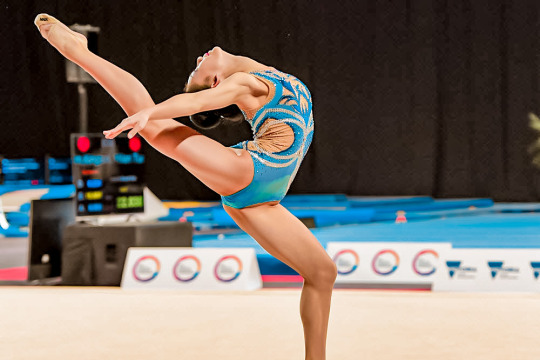
[all rights reserved to the original owner of the graphic: Gymnastics Australia]
Rules of the Game
Rhythmic gymnastics, like every other sport in the world, also has a set of rules that govern the smoothness of the games and make sure that fairness is always observed all throughout each competition. The following rules were taken from the respective sources to be mentioned:
(MasterClass, 2020)
Each rhythmic gymnastics routine must contain events that are ranked as being sufficiently difficult by the FIG. Apparatus manipulation is a key component in receiving a top score, with points deducted for technical faults. In the hoop, ball, and ribbon rhythmic events, one of these difficulties must be performed with the non-dominant hand.
Rhythmic gymnastics choreography must cover the entire floor. The choreography must feature a balanced choice of the groups of elements. This includes jumps, leaps, pivots, balances, and flexibility movements. Body movement should be fluid and musical, even displaying elements of ballet.
Each routine is scored by two panels of judges. The first panel judges the composition of the routine, where the overall array of rhythmic gymnastics events is scrutinized. The second panel judges the execution of these events.
Each individual exercise operates on a base score 9.60 points. Exceptional performances may receive bonus points, which vary between Junior Olympic and and standard Olympic (aka senior) gymnastics circuits. In the senior circuit, bonuses can reach 0.40 points, while in the junior circuit, bonuses can reach up to 0.20 points. Accordingly, senior competitors can max out at 10.00 points while juniors can max out at 9.80 points.
Group exercises have a base score of 19.20. Including potential bonus points, the maximum score for group exercise is 20.00.
(ActiveSG, n.d.)
During the individual programme, an athlete will manipulate only one of these five apparatuses at a time - rope, hoop, ball, clubs and ribbon. One apparatus is rotated out of contention every two years, with the gymnast required to compete on the remaining four events.
The group programme consists of five gymnasts competing in two different routines. In one routine, all of the athletes use the same apparatus. In the second routine, the gymnasts use two different pieces of equipment.
All routines must be performed with music, with only short pauses of music allowed. The choreography must centre around a theme that is developed from beginning to end using a variety of body movements and the handling of apparatuses.
The gymnast must keep the ribbon in motion throughout the entire routine.
All leaps and jumps must be of a good height, have a clear shape and good amplitude. All leaps with the back arched must have the head in contact with the leg.
All balances must be performed on the toes or the knee. These must be held clearly and have a good, fixed shape. All pivot combinations must be performed entirely on the toes without heel support.
(Grassie, 2016)
Individual routines are performed to music and last from 75 to 90 seconds.
A penalty of .05 points will be assessed for every second over or under the time allowed. The clock begins as soon as the gymnast begins moving and stops as soon as the gymnast is motionless.
The gymnast is required to be in contact with her apparatus before beginning her routine. She also is obliged to finish her exercise either holding her apparatus or having any part of her body in contact with it.
For small faults, .10 points are subtracted from a competitor's score.
For medium faults, .20 points are deducted.
For major faults, the penalty is .30 or greater.
COMMON PENALTIES:
If a gymnast drops the apparatus, she is penalized .30 points if she can retrieve it without any traveling, .50 points if the apparatus is retrieved after traveling 1-2 steps, .70 points if the apparatus is retrieved after more than 3 steps or outside the floor area.
If a gymnast crosses the boundary of the floor during an exercise, she is assessed a .30-point penalty.
If the apparatus breaks or is lost by a gymnast during an exercise, the gymnast is not permitted to restart the exercise. She may continue with a replacement apparatus, but will incur a 0.70-point penalty.
When performing jumping and balancing maneuvers, gymnasts can be penalized points for a lack of amplitude, a heavy landing or a lack of fixed or well-defined shape.
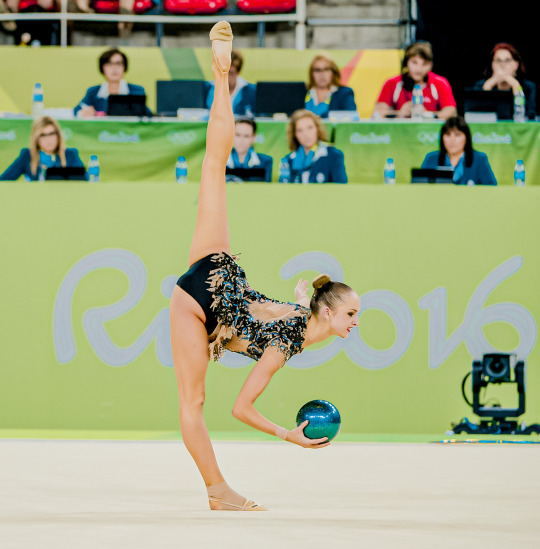
[all rights reserved to the original owner of the graphic: Wikimedia Commons]
Who officiates the sport? And how do they do it?
In order to retain order and fairness through and within the sport, there are several people who are appointed as the officiating officials, in charge of upholding the rules of rhythmic gymnastics and of doing justice to the deserving winner of each competition. In total, there are about 3 kinds of officials for the sport.
The first kind of official is the referee, and according to the manual written by Rene Niccollai (1989), whoever is appointed to the position would bear the responsibility of checking the athletes’ apparatuses and making sure they fit the requirements and the regulations; enforcing the rules and regulations; penalizing any athlete or coach who will act in misconduct; and seeing through the smooth order of the match. The second kind of official are the timers, and they will operate the stopwatches to keep track of time for each routine, as well as enforce the time limitation, i.e., determining if the routine was under or over the required time.
Lastly, the third kind of official are the judges. As stated in Julie Grassie’s article (2016), “there are two juries; one with four judges and one with five. The jury with four judges determines the difficulty (D) score. They evaluate the routine's technical value, including body difficulty (jumps, leaps, balances), apparatus mastery and originality, dynamic elements (throws and rotations of apparatus) and dance steps combinations. The highest and lowest scores are dropped, and the middle two scores are averaged. The maximum D score is 10.0 points. On the other hand, the jury with five judges determines the execution (E) score. They evaluate the artistic components of the routine, the unity of composition, use of space, body movements, correlation between the music and movement, even use of right and left hands and any technical vaults. The highest and lowest scores are dropped, and the middle three scores are averaged. The maximum E score is 10.0 points.”
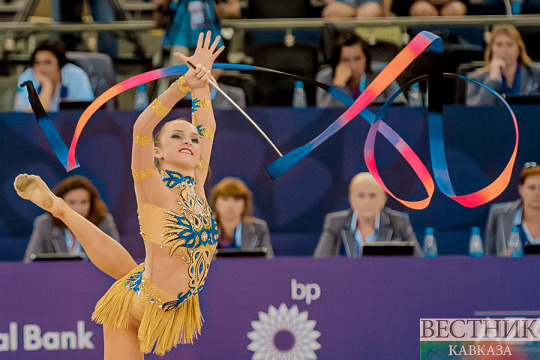
[all rights reserved to the original owner of the graphic: Vestnik Kavkaza]

Please head on to the second part of this blog to find the actual review. Thank you, and I'll see you there!

References
ActiveSG. (n.d.). Rhythmic gymnastics apparatuses and rules. Retrieved April 13, 2021, from ActiveSG: https://www.myactivesg.com/Sports/Gymnastics/How-To-Play/Gymnastics-for-Beginners/Rhythmic-gymnastics-apparatuses-and-rules#:~:text=The%20gymnast%20must%20keep%20the%20ribbon%20in%20motion%20throughout%20the%20entire%20routine.&text=All%20leaps%20and%20ju
Dallas, G., Tasika, N., Tsopani, D., & Tinto, A. (2012, January). The effect of different teaching systems in learning rhythmic gymnastics apparatus motor skills. Science of Gymnastics Journal, 4(1), 55-62. Retrieved April 13, 2021, from https://www.researchgate.net/publication/259463453_The_effect_of_different_teaching_systems_in_learning_rhythmic_gymnastics_apparatus_motor_skills
Department of Local Government, Sport and Cultural Industries, Government of Western Australia. (2019, July 12). Gymnastics. Retrieved April 12, 2021, from Department of Local Government, Sport and Cultural Industries: https://www.dlgsc.wa.gov.au/sport-and-recreation/sports-dimensions-guide/gymnastics
Erika. (2020, July). 5 WAYS TO IMPROVE RHYTHMIC GYMNASTICS AT HOME. Retrieved April 13, 2021, from Balance Academy: http://www.balanceacademy.asia/education/5-ways-to-improve-rhythmic-gymnastics-at-home/
GKD Gymnastics. (2019, March 13). Want to be a great gymnast? Follow these tips.... Retrieved April 13, 2021, from GKD Gymnastics web site: https://www.gkdgymnastics.com/blog/want-to-be-a-great-gymnast-follow-these-tips/
Grassie, J. (2016, March 2). Rhythmic gymnastics 101: Scoring. Retrieved April 13, 2021, from NBC Universal Pyeongchang Olympics web site: http://archivepyc.nbcolympics.com/news/rhythmic-gymnastics-101-scoring
Gymnastics in Vernon. (n.d.). Okanagan Rhythmic Gymnastics Competitive Parent Handbook. Retrieved April 13, 2021, from http://www.gymnasticsinvernon.com/wp-content/uploads/Apparatus-and-Equipment.pdf
MasterClass. (2020, November 8). A Guide to Competitive Rhythmic Gymnastics. Retrieved April 13, 2021, from MasterClass Articles: https://www.masterclass.com/articles/a-guide-to-competitive-rhythmic-gymnastics#what-is-rhythmic-gymnastics
Niccollai, R. (1989, May). Gymnastics. Selected Coaching Articles. Officiating. Retrieved April 13, 2021, from Eric Institute of Education Sciences: https://files.eric.ed.gov/fulltext/ED312217.pdf
Special Olympics. (2008, August). Special Olympics Rhythmic Gymnastics Coaching Guide. Retrieved April 13, 2021, from http://media.specialolympics.org/soi/files/sports/Gymnastics_Rhythmic/eyxkoe5y/Teaching.pdf
USA Gymnastics. (n.d.). Beginning Rhythmic Skill Lists and Instructor Tips. Retrieved April 13, 2021, from https://usagym.org/PDFs/Rhythmic/resources/beginningskilllists.pdf
Wikipedia. (2021, February 22). Rhythmic Gymnastics. Retrieved April 13, 2021, from Wikipedia: https://en.wikipedia.org/wiki/Rhythmic_gymnastics
3 notes
·
View notes
Text
OSRR: 1576
so last christmas erika paid for an introductory flight lesson at the local airport's flight club. and just today i was able to pick it up. that should tell you how ridiculous my brain is to get around to do simple tasks, like picking up a gift certificate. in the meantime i have my flight scheduled for next saturday. :)
i went and ran some errands today, and got things i've been meaning to get, like new leggings and some scarves that aren't just gray and yellow. given i love the combination, not everything i have will go with those. so i got some new scarves. and leggings. and there was a booth of see's candies so i got some of those too. and where i got the scarves i got a wrist holder for my keys and my wallet thing, so i don't have to hold the loops with a single finger, instead being able to just slip it on my wrist or hang it over my hand instead of shoving it in my armpit. makes life easy because it has a clip for my keys too. now i have a spot for everything.
on my way into the mall though, i decided i was done. done with not talking to jack, done with trying to talk to him, done with it all. i can't force someone to talk to me or to be my friend, so i decided i would drop it. i would still be friendly if i saw him, because working in nashua today it would perhaps be inevitable, but i decided i was done and that was that. i texted tanya and nick and anastasia and it made me feel good. i walked out with my shoulders square and my head held high. and that's a good accomplishment.
i picked up my pieces and brought them to the store, i sent that file, and i picked up the counter dice nashua needed that i forgot yesterday, and i went to work. i mostly inspected games we're gonna buy to make sure they were all there, and then a few hours in i heard a familiar voice and i looked up and it was jack.
i decided to ignore him.
but erika called me up, and he was at the counter, so i said hi, because that's what you do. if a person is there, you greet them. so i did. when i was done, i returned to my seat. for a moment at one point he actually came over to me and asked what i was doing, so i told him i was counting all the pieces for these games. he said "that must be fun," so i kinda shrugged and said something like "well it's a thing so sorta," or something like that. but that was it. i still sat straight up, with my shoulders back and my head high, partially for posture but mostly because i am good. i am good by myself. i don't need the negativity of someone who won't respond to me with words when i ask for them. typing a few words isn't that difficult. it may take a few days or hours to get them out, but they are only just a bunch of letter strung together to make sense. so yeah. done.
but a few times he spoke to me and it was way less awkward and tense than i thought it would be. and heading his voice again was good. regardless what my brain is telling me, i still have some feelings, but i'm working on it.
yeah.
it was odd, i guess. but it was a thing, it happened, and it appears there is no bad blood. which i'm good with. just be nice, and i'll have no problems. sure we won't be close or hang out, i'm assuming, at least nowhere in the near future. but if/when i see him again, he won't be mad and i won't be either. we won't be upset. an acquaintance, i guess. we are acquainted, i suppose, so that's what it is. not close (not anymore), but i know him. and that's fine.
i'm good, i guess.
but now i'm exhausted again because i don't know limits and i have no sense of self-preservation.
¯\_(ツ)_/¯
6 notes
·
View notes